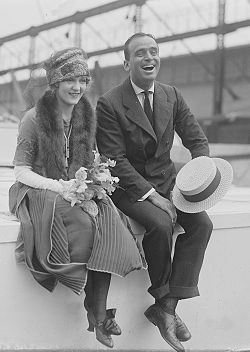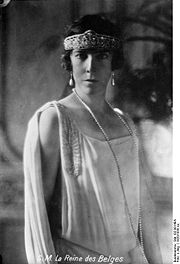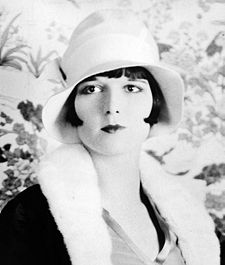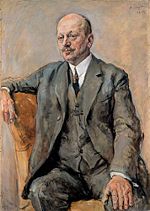
1920s in fashion
Encyclopedia

1920s
File:1920s decade montage.png|From left, clockwise: Third Tipperary Brigade Flying Column No. 2 under Sean Hogan during the Irish Civil War; Prohibition agents destroying barrels of alcohol in accordance to the 18th amendment, which made alcoholic beverages illegal throughout the entire decade; In...
is the decade in which fashion entered the modern era. It was the decade in which women first liberated themselves from constricting fashions and began to wear more comfortable clothes (such as short skirts or trousers). Men likewise abandoned overly formal clothes and began to wear sport clothes for the first time. The suits men wear today are still based, for the most part, on those men wore in the late 1920s. Their hats were somewhat different.
The 1920s are characterized by two distinct period of fashion. In the early 1920s change progressed slowly, as many were reluctant to adopt new styles. From 1925, the public passionately embraced the styles associated with the Roaring Twenties
Roaring Twenties
The Roaring Twenties is a phrase used to describe the 1920s, principally in North America, but also in London, Berlin and Paris for a period of sustained economic prosperity. The phrase was meant to emphasize the period's social, artistic, and cultural dynamism...
. These styles continue to characterize fashion until early in 1932.
Overview
After World War IWorld War I
World War I , which was predominantly called the World War or the Great War from its occurrence until 1939, and the First World War or World War I thereafter, was a major war centred in Europe that began on 28 July 1914 and lasted until 11 November 1918...
, America entered a prosperous era and, as a result of its role in the war, came out onto the world stage. Social customs and morals were relaxed in the optimism brought on by the end of the war and the booming of the stock market
Stock market
A stock market or equity market is a public entity for the trading of company stock and derivatives at an agreed price; these are securities listed on a stock exchange as well as those only traded privately.The size of the world stock market was estimated at about $36.6 trillion...
. Women were entering the workforce in record numbers. The nationwide prohibition
Prohibition in the United States
Prohibition in the United States was a national ban on the sale, manufacture, and transportation of alcohol, in place from 1920 to 1933. The ban was mandated by the Eighteenth Amendment to the Constitution, and the Volstead Act set down the rules for enforcing the ban, as well as defining which...
on alcohol was ignored by many. There was a revolution in almost every sphere of human activity, and fashion was no exception.
The technological development of new fabrics and new closures in clothing affected fashions of the 20s. Natural fabrics such as cotton and wool were the abundant fabrics of the decade. Silk was highly desired for its luxurious qualities, but the limited supply made it expensive. In the late 19th century, "artificial silk" was first made from a solution of cellulose in France. After being patented in the United States, the first American plant began production of this new fabric in 1910; this fiber became known as rayon
Rayon
Rayon is a manufactured regenerated cellulose fiber. Because it is produced from naturally occurring polymers, it is neither a truly synthetic fiber nor a natural fiber; it is a semi-synthetic or artificial fiber. Rayon is known by the names viscose rayon and art silk in the textile industry...
. Rayon stockings became popular in the decade as a substitute for silk stockings. Rayon was also used in some undergarments. Many garments before the 1920s were fastened with buttons and lacing, however, during this decade, the development of varieties of metal hooks and eyes meant that there were easier means of fastening clothing shut. Hooks and eyes, buttons, zippers or snaps were all utilized to fasten clothing.
Womenswear


Sportswear (fashion)
Sportswear has been called America's main contribution to the history of fashion design. The term became popular in the 1920s to describe relaxed, casual wear typically worn for spectator sports...
into the greatest change in post-war fashion. The tubular dresses of the 'teens had evolved into a similar silhouette that now sported shorter skirts with pleats, gathers, or slits to allow motion.
The straight-line chemise topped by the close-fitting cloche hat became the uniform of the day. Women "bobbed," or cut,thier hair short to fit under the popular hats, a radical move in the beginning, but standard by the end of the decade. Low-waisted dresses with fullness at the hemline allowed women to literally kick up their heels in new dances like the Charleston.
In the world of art, fashion was being influenced heavily by art movements such as surrealism
Surrealism
Surrealism is a cultural movement that began in the early 1920s, and is best known for the visual artworks and writings of the group members....
. After World War I, popular art saw a slow transition from the lush, curvilinear abstractions of art nouveau
Art Nouveau
Art Nouveau is an international philosophy and style of art, architecture and applied art—especially the decorative arts—that were most popular during 1890–1910. The name "Art Nouveau" is French for "new art"...
decoration to the more mechanized, smooth, and geometric forms of art deco
Art Deco
Art deco , or deco, is an eclectic artistic and design style that began in Paris in the 1920s and flourished internationally throughout the 1930s, into the World War II era. The style influenced all areas of design, including architecture and interior design, industrial design, fashion and...
. Elsa Schiaparelli
Elsa Schiaparelli
Elsa Schiaparelli was an Italian fashion designer. Along with Coco Chanel, her greatest rival, she is regarded as one of the most prominent figures in fashion between the two World Wars. Starting with knitwear, Schiaparelli's designs were heavily influenced by Surrealists like her collaborators...
is one key Italian designer of this decade who was heavily influenced by the "beyond the real" art and incorporated it into her designs.
The boyish figure
Undergarments began to transform after World War I to conform to the ideals of a flatter chest and more boyish figure. The women's rights movementWomen's rights
Women's rights are entitlements and freedoms claimed for women and girls of all ages in many societies.In some places these rights are institutionalized or supported by law, local custom, and behaviour, whereas in others they may be ignored or suppressed...
had a strong effect on women's fashions. Most importantly, the confining corset was discarded, replaced by a chemise or camisole and bloomers, later shortened to panties or knickers. During the mid-twenties all-in-one lingerie became popular.
For the first time in centuries, women's legs were seen with hemlines rising to the knee and dresses becoming more fitted. A more masculine look became popular, including flattened breasts and hips, short hairstyles such as the bob cut, Eton Crop and the Marcel Wave. The fashion was bohemian and forthcoming for its age.
One of the first women to wear trousers, cut her hair and reject the corset was Coco Chanel
Coco Chanel
Gabrielle Bonheur "Coco" Chanel was a pioneering French fashion designer whose modernist thought, menswear-inspired fashions, and pursuit of expensive simplicity made her an important figure in 20th-century fashion. She was the founder of one of the most famous fashion brands, Chanel...
. Probably the most influential woman in fashion of the 20th century, Coco Chanel did much to further the emancipation and freedom of women's fashion.
Jean Patou
Jean Patou
- Early life :Patou was born in Normandy, France in 1880. Patou's family's business was tanning and furs. Patou worked with his uncle in Normandy, then moved to Paris in 1910, intent on becoming a couturier.-1910s - World War I and later:...
, a new designer on the French scene, began making two-piece sweater and skirt outfits in luxurious wool jersey and had an instant hit for his morning dresses and sports suits. American women embraced the clothes of the designer as perfect for their increasingly active lifestyles.
By the end of the Twenties, Elsa Schiaparelli
Elsa Schiaparelli
Elsa Schiaparelli was an Italian fashion designer. Along with Coco Chanel, her greatest rival, she is regarded as one of the most prominent figures in fashion between the two World Wars. Starting with knitwear, Schiaparelli's designs were heavily influenced by Surrealists like her collaborators...
stepped onto the stage to represent a younger generation. She combined the idea of classic design from the Greeks and Romans with the modern imperative for freedom of movement. Schiaparelli wrote that the ancient Greeks "gave to their goddesses ... the serenity of perfection and the fabulous appearance of freedom." Her own interpretation produced evening gowns of elegant simplicity. Departing from the chemise, her clothes returned to an awareness of the body beneath the evening gown.
Style gallery 1920–25
- 1920 summer sport suit.
- The forehead was usually covered in the 1920s, here by a hat reaching to the eyebrows.
- 1922 Rolled stockings.
- Dress of 1923 has a dropped waist and width at the hips.
- Teenage girls in Minnesota wear breeches and riding boots with men's neckties, 1924.
- By 1925, skirts ended just below the knee. Tunic-tops and sweaters reaching to the hips were popular.
- Woman with bobbed hair in breeches and boots, 1920s.
- Actress Evelyn BrentEvelyn BrentEvelyn Brent was an American film and stage actress.-Early life:Born Mary Elizabeth Riggs in Tampa, Florida and known as Betty, she was a child of 10 when her mother Eleanor died, leaving her father Arthur to raise her alone...
, in the mid-1920s with bobbed hair.
Style gallery 1926–29
- Actress Aileen PringleAileen PringleAileen Pringle was an American stage and film actress during the silent film era.-Early life:Born Aileen Bisbee into a prominent and wealthy San Francisco, California family and educated in Europe, Pringle began her acting career shortly after her 1916 marriage to Charles McKenzie Pringle, the son...
wears a cloche hat and boldly patterned coat, 1926. - Actress Alice JoyceAlice JoyceAlice Joyce was an American actress, who appeared in more than 200 movies during the 1910s and 1920s, perhaps best known for her roles in the 1923 silent and 1930 talking versions of The Green Goddess....
in a straight evening gown with a sheer beaded overdress, 1926. - This 1926 painting shows the mid-decade silhouette at its simplest: languid pose, bobbed hair, knee-length dress with dropped waist.
- Evening gown of 1926 featured simple lines and emphasis at the hips. Hair is parted to one side and worn in soft waves. Portrait of Alisa Mellon Bruce, 1926.
- Designers used multiple hemlines (here, tiers of ruffles) to accustom the eye to longer skirts. This evening gown foreshadows the higher waist and feminine look that spread to everyday fashion by the early 1930s.
- May 1928, abdomen and curves. After many years of a "stovepipe" silhouette, "natural" curves were beginning to reappear.
- Knee-length, pleated skirts and dropped waists were still popular as everyday clothes in 1929, though Paris designers were already showing longer skirts and higher waistlines.
- Bridesmaids gowns of 1929 have knee-length underskirts and longer, sheer over skirts, foreshadowing the trend toward longer skirts. Minnesota, 1929
Menswear

By 1925, wider trousers commonly known as "Oxford Bags
Oxford bags
Oxford bags were a loose-fitting baggy form of trousers favoured by members of the University of Oxford, especially undergraduates, in England during the early 20th century from the 1920s to around the 1950s...
" came into fashion, while suit jackets returned to a normal waist and lapels became wider and were often worn peaked. Loose fitting sleeves (without a taper) also began to be worn during this period. During the late 1920s, double breasted vests, often worn with a single breasted jacket, also became quite fashionable. During the 1920s, men had a variety of sport clothes available to them, including sweaters and short trousers, commonly known as knickers. For formal occasions in the daytime, a morning suit was usually worn. For evening wear men preferred the short tuxedo to the tail coat, which was now seen as rather old-fashioned and snobby.
Men's hats
Men's hats were usually worn depending on their class, with upper class citizens usually wearing top hats or a homburg hatHomburg (hat)
A homburg is a felt hat, a Tyrolean hat-style fedora, characterized by a single dent running down the center of the crown and a stiff brim shaped in a "kettle curl". The Homburg is a stiff, formal felt hat....
. Middle class men wore either a fedora or a trilby hat. During the summer months a straw boater was popular for upper class and middle class men. Working-class men wore a standard Newsboy cap
Newsboy cap
The newsboy cap or newsy cap is a casual-wear cap similar in style to the flat cap. Sometimes also referred to as the: Baker Boy, Apple Cap, Eight Panel, Cabbie, Jay Gatsby , Fisherman's Cap, Pageboy and Lundberg Stetson.It has the same overall shape and stiff peak in front as a flat cap, but the...
or no hat at all.
Style gallery
- Photographer Clarence Hudson WhiteClarence Hudson WhiteClarence Hudson White was an American photographer, teacher and a founding member of the Photo-Secession movement. He grew up in small towns in Ohio, where his primary influences were his family and the social life of rural America. After visiting the World's Columbian Exposition in Chicago in...
, c. 1920. - Politician William J. FieldsWilliam J. FieldsWilliam Jason Fields was a politician from the U.S. state of Kentucky. Known as "Honest Bill from Olive Hill", he represented Kentucky's Ninth District in the U.S...
wears an overcoatOvercoatAn overcoat is a type of long coat intended to be worn as the outermost garment. Overcoats usually extend below the knee, but are sometimes mistakenly referred to as topcoats, which are short coats that end at or above the knees. Topcoats and overcoats together are known as outercoats...
and soft-crowned hat with a bow tieBow tieThe bow tie is a type of men's necktie. It consists of a ribbon of fabric tied around the collar in a symmetrical manner such that the two opposite ends form loops. Ready-tied bow ties are available, in which the distinctive bow is sewn into shape and the band around the neck incorporates a clip....
, December 1923. - Publisher Edward Beale McLeanEdward Beale McLeanEdward Beale "Ned" McLean was the publisher and owner of the Washington Post newspaper from 1916 until 1933.Edward McLean was born into a publishing fortune founded by his paternal grandfather Washington McLean, who owned the Washington Post and the Cincinnati Enquirer...
wears a three-piece striped suit with a spread-collar shirt, 1924. - Men wear morning dressMorning dressMorning dress is the daytime formal dress code, consisting chiefly for men of a morning coat, waistcoat, and striped trousers, and an appropriate dress for women...
and spats in this 1929 wedding photo. - Ronald Reagan as a teenager wearing knickerbockers.
- Man in 1927 wearing a Panama hatPanama hatA Panama hat is a traditional brimmed hat of Ecuadorian origin that is made from the plaited leaves of the toquilla straw plant...
and buttoned waistcoatWaistcoatA waistcoat or vest is a sleeveless upper-body garment worn over a dress shirt and necktie and below a coat as a part of most men's formal wear, and as the third piece of the three-piece male business suit.-Characteristics and use:...
. - Charles Lawrence, 1st Baron Lawrence of Kingsgate wears a stuff collar and bow tie.
- German aviators, one a prince, 1929
Children's fashion
- Roller-skater, Mississippi, 1921
- Knee-length dress worn with anklets and Mary JanesMary Jane (shoe)Mary Jane is an American term for a strap shoe or bar shoe that typically has low heels, broad and rounded closed toes, and a single-buckle strap across the instep and/or around the ankle...
, 1923. - Children's fashion, Germany, 1925
- Two-year-old Paulina, with her mother Alice Roosevelt LongworthAlice Roosevelt LongworthAlice Lee Roosevelt Longworth was the oldest child of Theodore Roosevelt, the 26th President of the United States. She was the only child of Roosevelt and his first wife, Alice Hathaway Lee....
, wears a winter costume of coat and trousers, 1927. - Young boy wears a sailor suitSailor suitA sailor suit is a uniform traditionally worn by enlisted seamen in the navy, and other government funded sea services. It later developed in to a popular clothing style for children....
.

